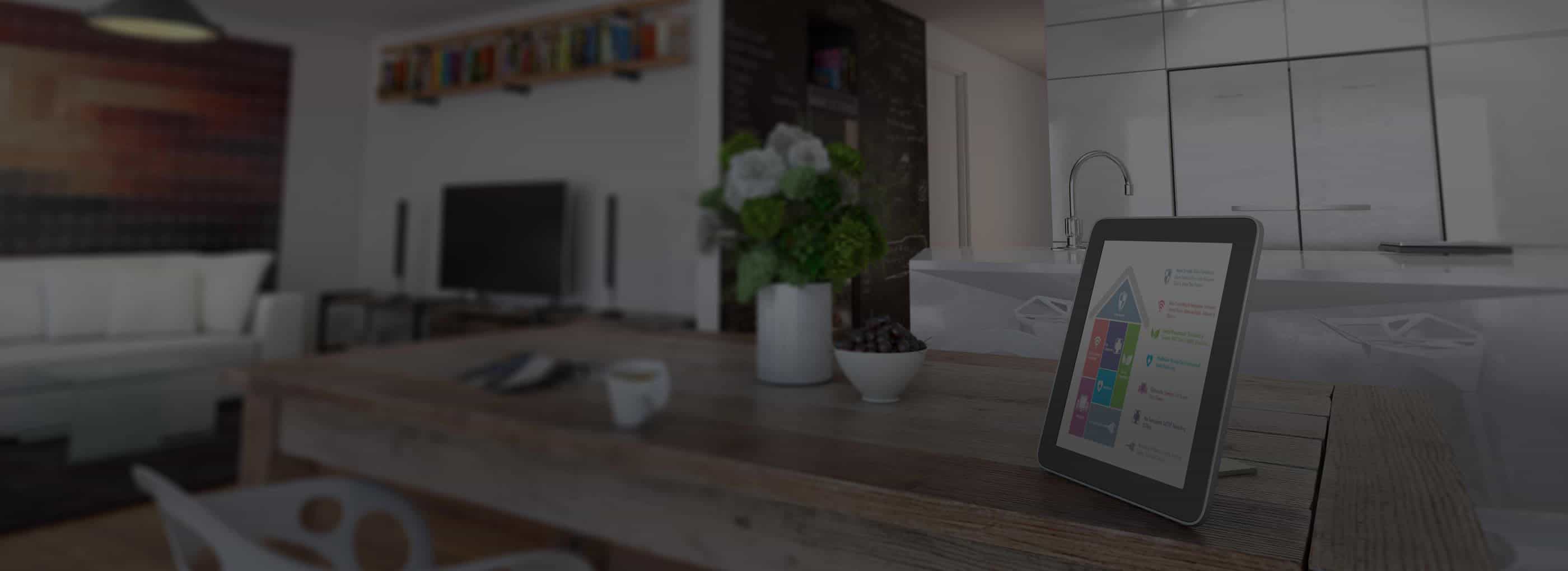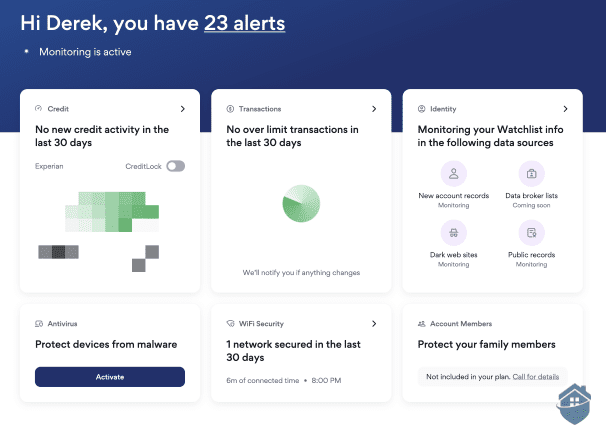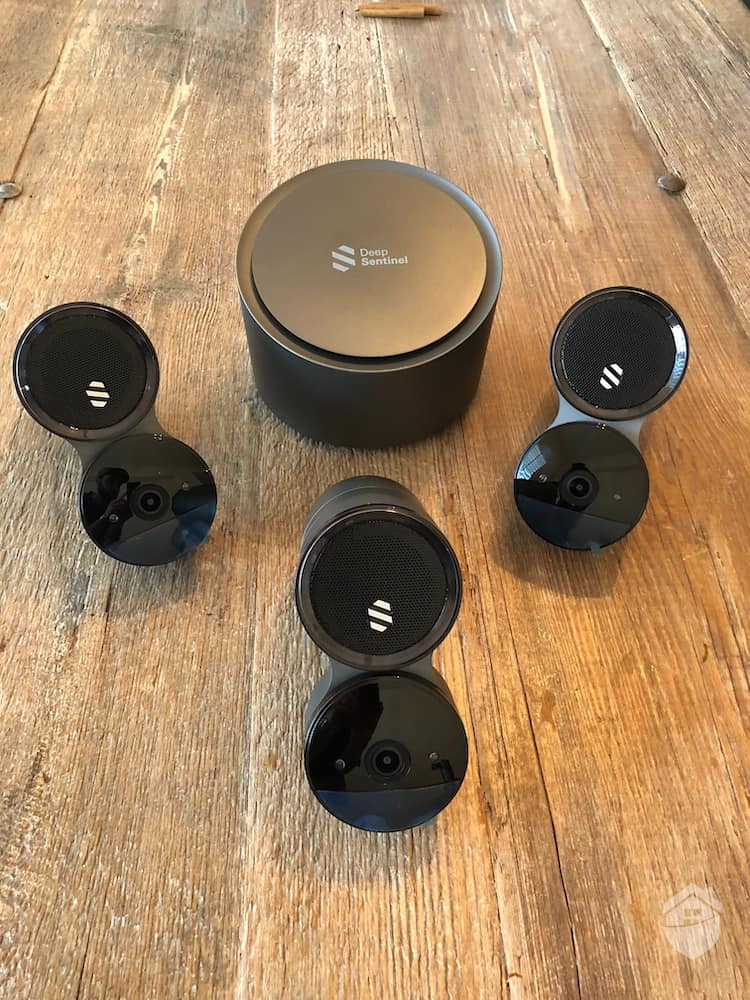Smart security lighting has revolutionized home protection, but with electricity costs rising by as much as 22 percent in 2025,1 we also have to think about how we can make security lighting energy efficient.
We created this guide to ensure your electricity bill doesn’t skyrocket even with additional security lighting protecting your home. Our experts have researched and tested energy-saving strategies. And we found ways to lower electricity consumption by as much as 35 percent. Let’s dig in.
How Much Electricity Do Smart Lights Consume?
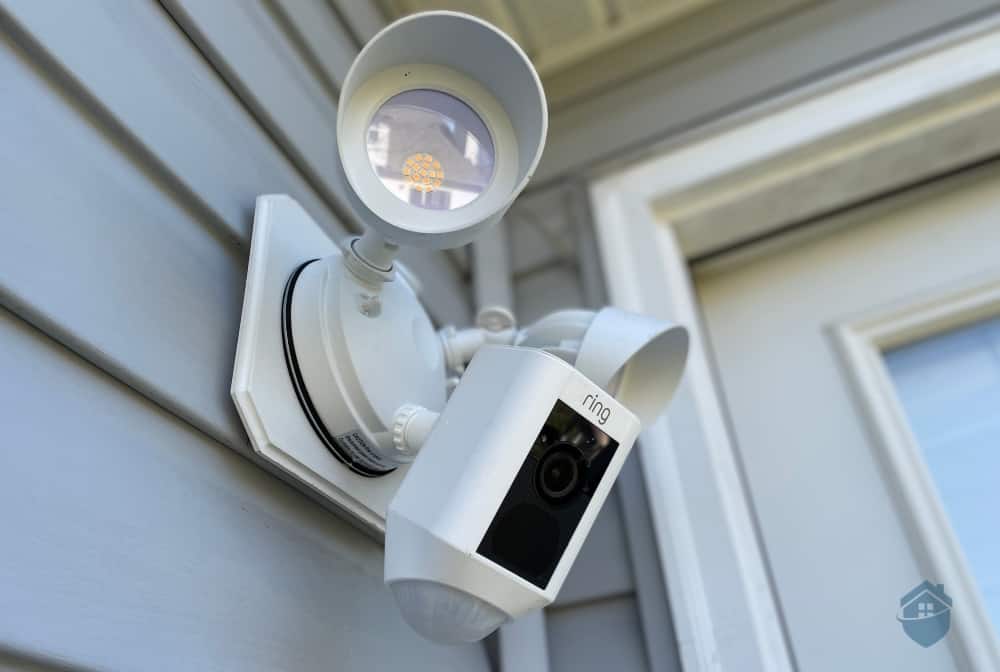
We installed our Ring Cam Floodlight at our entryway to spook off anyone trying to break in.
Let us start by saying that smart security lights consume less energy than traditional halogen or incandescent outdoor lights. This is because smart security lights typically use LED bulbs, which use up about 75 percent less power than incandescent lights.2
Additionally, smart lights don’t just rely on manual and scheduled switches that may leave traditional outdoor lights on for longer than required. We’ve seen smart lights with motion sensors, ambient sensors, and programmable schedules that help them decide when to turn on and off. So, in a way, being “smart” alone makes smart lights more energy-efficient than traditional outdoor lights.
>> Product Breakdown: Ring Floodlight Cam Review and Pricing
Energy Usage Breakdown by Light Type
Let’s talk numbers. Here’s how different outdoor lighting options compare in terms of energy consumption:
| Light Type | Wattage | Annual Energy Cost* | Lifespan |
|---|---|---|---|
| Incandescent Floodlight | 150 W | $26.28 | 1,000 hours |
| Halogen Security Light | 100 W | $17.52 | 2,000 hours |
| LED Floodlight | 30 W | $5.26 | 25,000 hours |
| Smart LED Security Light | 20 W | $3.50 | 25,000 hours |
*Based on average U.S. electricity rate of $0.12/kWh and 4 hours daily use
Compared to traditional LED floodlights, smart LED security lights achieve lower wattage through advanced dimming capabilities. For instance, you can set your security lights to only provide half their power when you get home from work and only need enough light to unlock the front door. When a lurker strolls by late at night, though, they’ll still get the full power of the security light.
Did You Know? Motion-activated smart lights typically operate at full brightness for only 10 to 15 percent of nighttime hours. This dramatically reduces overall energy consumption compared to always-on traditional lighting.
Key Components of Energy-Efficient Smart Security Systems
An effective smart security lighting system consists of several interconnected components that work together to maximize both security and energy efficiency. If you are yet to set up your smart security lights, we recommend looking for options that offer these functions and capabilities.
Motion Sensing Technology
Modern smart security lights use passive infrared (PIR) motion sensors, microwave sensors, or both to detect movement. We found that PIR sensors are more energy-efficient than microwave sensors because they don’t need a constant supply of power. In terms of efficiency, PIR sensors can detect movement from up to 30 feet away.
We also recommend looking for motion-activated smart lights with adjustable sensitivity, especially if critters and pets frequent your backyard. Fine-tuning the sensitivity prevents false detections, and reduces the amount of time your security lights are on unnecessarily.
Additional Tip: Outdoor security cameras with built-in security lights also have detection zones. Setting up these zones tells the device to ignore areas where false detections typically occur, such as public sidewalks. Our list of the best outdoor security cameras include options with this feature.
Smart Controllers and Hubs
Connecting your smart security lights to a smart controller or hub centralizes control. This will make it easier for you to manage multiple lights, and also let you create complex automation rules that can help with security and energy savings. Our favorite options include:
- Dedicated security lighting hubs that act as specialized controllers designed specifically for outdoor lighting systems.
- Smart home platforms that enable integration with existing systems like SmartThings, Hubitat, or Home Assistant.
- App-based control that offers direct management through smartphone applications.
Our testing shows that smart home platforms such as Hubitat and Home Assistant offer more sophisticated controls and features. They also let you integrate smart lights with other smart home devices for smarter automations. However, hub-based systems are also more complex to set up.
The next best option, in our opinion, and dedicated smart light hubs. One example is the Hue Bridge for Philips Hue smart lights.
More Options: We also recommend looking into smart security systems, such as Vivint and ADT. These systems typically offer comprehensive smart light controls, while also integrating smart lights into a larger ecosystem of sensors and other smart devices.
Dimming and Brightness Controls
Adjustable brightness levels can reduce energy consumption by 10 to 50 percent depending on how they’re set up and how you use them. We recommend smart systems that offer the following features:
- Ambient Lighting Mode: The bulb automatically adjusts based on surrounding brightness. It provides just enough low-level illumination for visibility (about 10 to 20 percent of max brightness)
- Security Mode: This mode triggers when there’s a security threat detected by motion sensors or other means. The light turns on at full brightness to scare away intruders, and then turns off after a set period of time or when the threat is gone.
- Scheduled Dimming: With this feature, the bulbs automatically dim or brighten depending on time of day. For example, at sunset, they’ll turn on at about 10 percent brightness and then gradually brighten as evening sets in.
Solar Integration Options
Solar-powered smart security lights eliminate electricity costs entirely for appropriate installations. The solar security lights we tested could store enough energy to operate for three to five nights without direct sunlight.
However, solar options work best for lights that don’t require constant high-brightness operation. We recommend solar integration for pathway lighting and supplementary security illumination rather than primary security floodlights.
FYI: Solar security lights work most effectively when positioned to receive four to six hours of direct sunlight daily and are rated for at least 2,000 mAh battery capacity.
Our Recommendations: Scheduling and Automation Strategies
Choosing smart security lights with the right features is just half of the equation. It’s how you use those features that matters most in terms of saving energy. Like we said up top, we tested different strategies over a period of three months, and here are our recommendations.
If Your Security Lights Have Time-Based Scheduling
To start, we recommend setting up the following time-based schedules for your smart security lights:
- Sunset/Sunrise Automation: Lights activate based on actual daylight conditions rather than fixed times
- Weekend/Weekday Variations: Different lighting patterns based on when you’re typically home
- Vacation Modes: Randomized lighting patterns to simulate occupancy which is one of the best ways to deter burglars with smart lights while maintaining energy efficiency
>> Read More: 5 Sneaky Tricks to Keep Burglars Away While You’re on Vacation
Occupancy-Based Automation
If possible, we also recommend integrating your smart lights with other sensors in your home. For example, if you have a smart security system, you may be able to make automation rules that turn on your outdoor lights based on door activity as detected by your entry sensors. Here are some other examples:
- Porch lights turn on when the front door smart lock is accessed from the inside
- Indoor lights turn on when door is opened
- Kitchen light turns on when motion sensor detects movement in the kitchen
- Pathway lights turn on when your security system detects that your phone’s location has entered a geofenced area around your home
We recommend taking a look at our Vivint review and Frontpoint review if you’re interested in those types of automation. Vivint has an excellent automation engine accessible through the Vivint smartphone app, while Frontpoint is one of the few systems we’ve tested that offer geofencing.
Weather-Responsive Adjustments
If you have a more advanced smart lighting system, you may also be able to create automatic adjustments based on weather conditions. For example:
- Cloudy day detection: Earlier smart light activation when natural light is reduced
- Rain/storm modes: Enhanced lighting during severe weather when security risks may increase
- Wind compensation: Lowers sensor sensitivity during windy days when false triggers are more likely to occur
Our testing revealed that weather-responsive systems reduce unnecessary lighting by an average of 12 percent compared to standard timer-based controls. However, not a lot of smart security lights offer those types of automation.
Integration with Security Systems
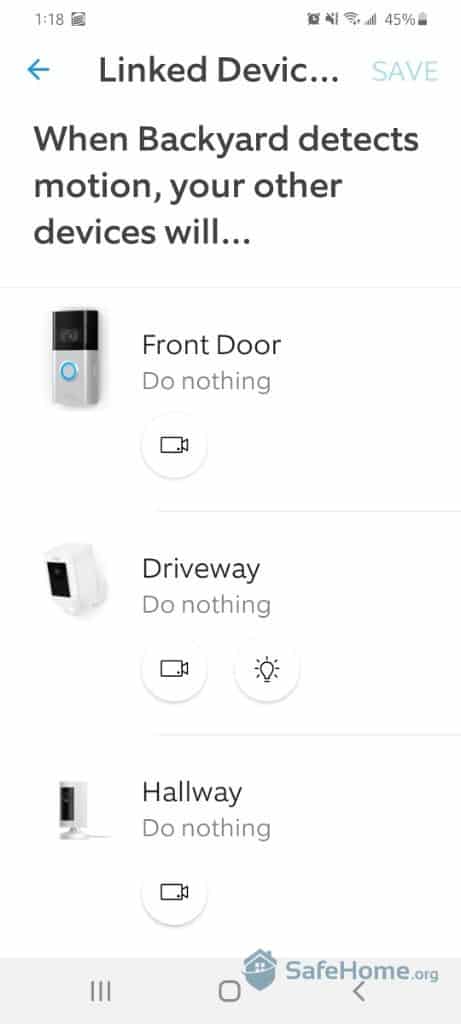
When our Ring Cam Floodlight detected motion, we could set our other cameras to take specific actions.
As mentioned earlier, integrating smart security lights with a security system with home automation can also be beneficial. Most of our top-rated security systems offer such integrations, from basic to advanced. At a minimum, though, we suggest pairing your smart lights with your security system to achieve:
- Alarm integration: Lights activate at full brightness or changes hue when security alarms trigger
- Camera coordination: When an outdoor camera starts recording, nearby security lights turn on to provide a clearer picture
- Smart lock connectivity: Pathway lighting activates when doors are unlocked remotely
Example: The Nest Cam with Floodlight, one of the security cameras offered by ADT, has built-in floodlights that you can configure to turn on when the camera detects movement. In addition to scaring away intruders, the floodlights aid in improving nighttime video quality.
Our Recommendations: Motion Detection Optimization
For smart security lights with motion detection, setting the motion sensor up is crucial for balancing security and energy efficiency. Poor sensor setup leads to frequent false activations, wasting energy and potentially reducing the system’s security value. Here are some strategies you can use:
>> Learn More: How Does a Motion Detector Work?
Setting Up Detection Zones
A few smart security lights offer adjustable detection zones that can be customized through smartphone apps. We see this feature most commonly in security cameras with built-in lights, because the camera’s computer vision is what typically provides zoning capabilities.
When setting up zones, make sure to include pathways, doorways, and other areas an intruder might walk on to get close to your house. However, we recommend excluding high-traffic areas such as sidewalks and the street.
Expert Insight: Properly configured motion zones can reduce false activations by 60 to 80 percent compared to default factory settings, significantly improving energy efficiency.
False Activation Prevention
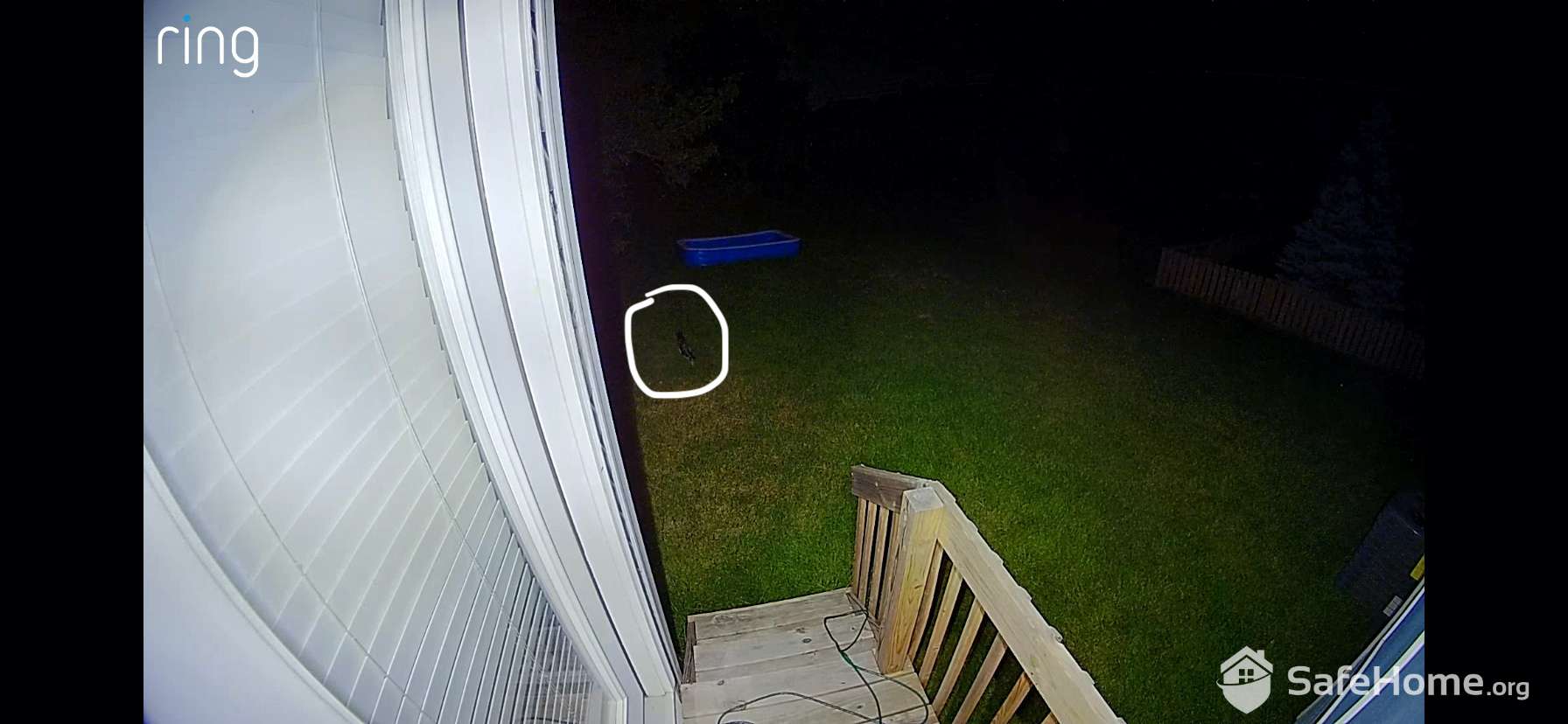
After a small bird set off our Ring Cam Floodlight’s motion detector, we had to fine-tune its sensitivity.
Of course, not all smart lights have zoning capabilities. Remember, it’s a pretty advanced feature. If you get a lot of false activations from your smart security lights, the first step in addressing them is knowing what’s causing them. In our experience, it’s usually environmental factors like objects blowing in the wind, animals running past the sensor, or cars driving by. Smart lights reduce the likelihood of these false triggers through:
- Size discrimination: Sensors that can distinguish between human-sized and smaller objects
- Duration filters: Requiring sustained motion for activation
- Multiple confirmation: Systems that require triggers from multiple sensors before activation
Advanced Detection Features
Premium smart security lights, particularly those with connected cameras, offer more advanced detection for fine-tuned triggers:
- Human Vs. Animal Recognition: AI-powered systems that differentiate between different types of movement
- Direction Detection: Sensors that activate only when movement is toward the property
- Speed Analysis: Systems that ignore very fast movement (like passing cars) or very slow movement (like swaying branches)
Energy-Savings Through LED Technology and Energy Ratings
LED technology has transformed security lighting efficiency, but not all LEDs are created equal. We recommend reviewing energy ratings and specifications to help you choose the most efficient options for your specific needs.
Energy Efficiency Ratings
Let’s start with the basics. A smart light’s energy efficiency is affected by several factors. We recommend looking at these to start:
- Lumens per watt (lm/W): Measures light output efficiency; look for ratings above 100 lm/W
- ENERGY STAR certification: Indicates products meet strict efficiency guidelines
- Color temperature: Measured in Kelvin (K); 4000-5000K provides good security visibility with reasonable energy consumption
- Color Rendering Index (CRI): When used alongside a security camera, lights with a higher CRI (80+ is what we look for) provide a better image quality.
Dimming Capabilities and Energy Savings
Dimmable LED security lights offer significant energy savings. Most LEDs rapidly cycle between on and off to provide the appearance of a dimmed light. This is called PWM dimming. More premium models actually dim the light through a module that varies the voltage supplied. Surprisingly, PWM dimming is more energy-efficient with LED lights, although we still prefer the softer lighting provided by the premium models.
Heat Management and Efficiency
An often overlooked aspect of managing the energy consumption of smart security lights is that their efficiency decreases as operating temperature increases. That’s why we recommend installing smart security lights in shaded areas so heat from the sun doesn’t cause them to lose efficiency. Also, avoid placing them over an air conditioning condenser or other fixtures that release heat.
How Long Does it Take to Recover an Investment in Smart Security Lighting?
Of course, smart lights cost more than traditional lights upfront. But, in the long run, they end up saving money by reducing your electric bill. Here’s a rough breakdown of how long it takes to recover your investment in smart security lighting compared to basic LED security lighting:
| Lighting Quality | Basic Smart Security Light | Mid-Range Smart Security Light | Premium Smart Security Light |
|---|---|---|---|
| Initial Investment for Four Units | $100 to $200 | $200 to $400 | $400 to $600 |
| Annual Maintenance Costs | $10 to $15 | $10 to $15 | $10 to $15 |
| Annual Energy Savings Compared to Traditional Lights | $45 | $55 | $75 |
| Return on Investment Timeline | Three to five years | Four to eight years | Five to eight years |
While these are rough numbers, they’re the average savings we experienced in a modern three-bedroom, two-bathroom house on about an acre of land with four smart security lights.
After hitting that initial return on investment timeline, you can expect to enjoy that annual savings until the light needs to be replaced. In our experience, smart security lights need to be replaced every 10 to 15 years.
Installation and Setup Best Practices
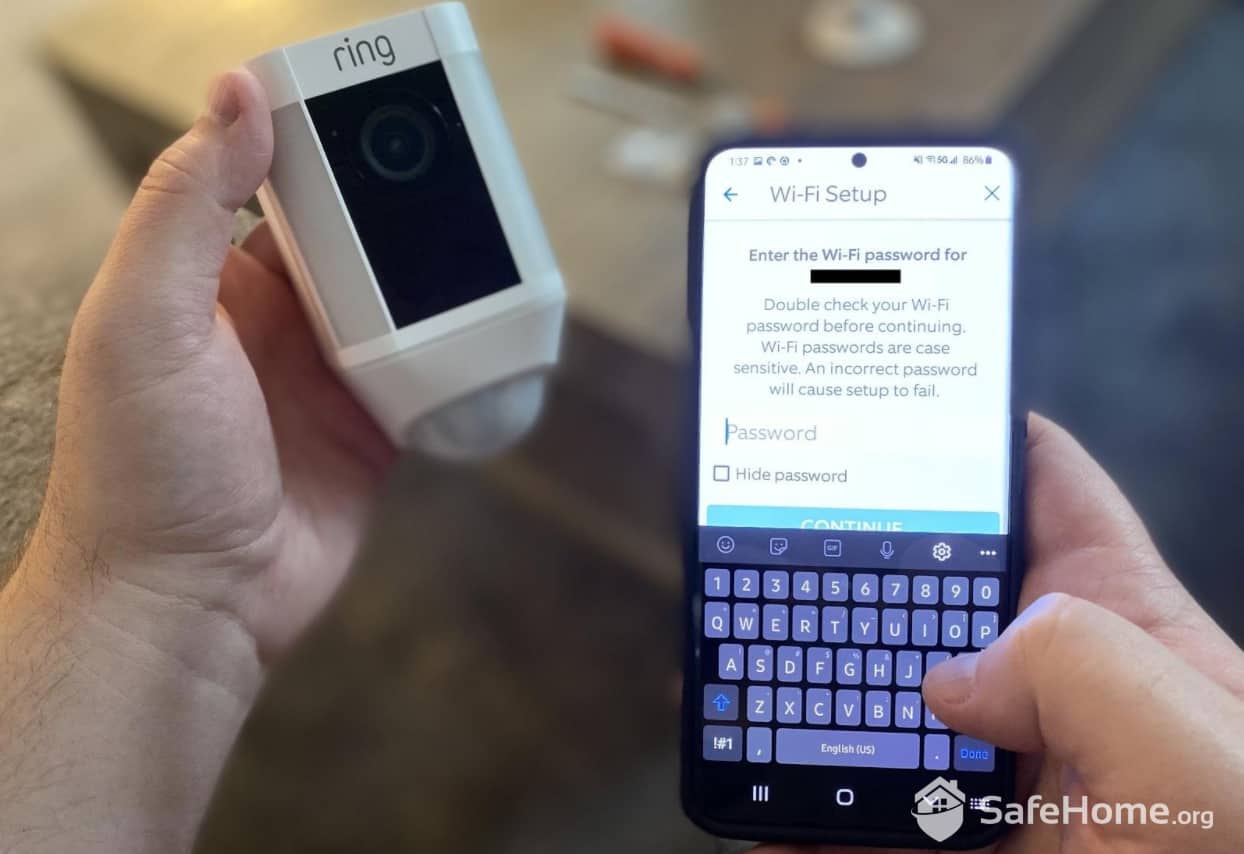
Here we are connecting our Ring Spotlight Cam, which has a built-in security light, to our Wi-Fi.
To make the most of your smart security lighting, it needs to be properly placed and installed. It’s kind of like figuring out where to place security cameras. You want to maximize coverage with the least amount of lights. Once you figure out where you want your lights to go, you’ll need to install them and set them up.
>> Check Out: Ring Spotlight Camera Review and Pricing
DIY vs. Professional Installation
Depending on the complexity of your smart security lights, you can opt to install them yourself or hire a professional. Here’s how we decide when to tackle the project on our own and when to bring in the pros:
- DIY Installation: We opt for a DIY installation for battery-powered or solar smart lights as that means there’s no wiring to deal with. We’ll also take the project on ourselves if it’s a direct replacement of an existing fixture.
- Professional Installation: When a smart security light requires new electrical wiring or circuit installation (i.e. smart lights fixtures) we always bring in the pros.
Always follow the manufacturer’s recommended installation guide when installing equipment on your own as each manufacturer has different requirements.
>> Read About: Best DIY Home Security Systems in 2025
Common Installation Mistakes to Avoid
Regardless of the manufacturer, there are a few common installation mistakes we see people make, such as:
- Incorrect sensor aiming: Improper angle reduces detection accuracy and wastes energy
- Inadequate network planning: Weak Wi-Fi signals cause connectivity issues and missed activations
- Overlooking maintenance access: Install lights where bulbs and sensors can be easily serviced
Pro Tip: We recommend testing all your smart lighting functions during the day. Use the manufacturer apps’ manual override features to ensure proper operation before relying on automated nighttime security.
Initial Configuration Steps
Once the light’s installed, you can configure its smart settings. Here’s the process we follow:
- Download Manufacturer Apps: Install and create accounts before beginning physical installation
- Update Firmware: Ensure all devices have latest software before configuration
- Create Zones and Groups: Organize lights logically for easier management
- Set Basic Schedules: Configure initial timing and brightness settings
- Test Motion Sensors: Verify proper detection zones and sensitivity
- Integrate with Other Systems: Connect to security panels, smart home hubs, or voice assistants
>> Learn About: 2025 Motion Sensor Buying Guide
Creating a Routine Maintenance Schedule
We break down our maintenance tasks into monthly, quarterly, and annual tasks. It shouldn’t take more than 30 minutes a month to keep your smart security light running at peak efficiency.
| Our Smart Security Light Maintenance Schedule | ||
|---|---|---|
| Monthly Maintenance Tasks | Quarterly Maintenance Tasks | Annual Maintenance Tasks |
|
|
|
Final Thoughts: Saving Money with Smart Home Energy Management for Security Lighting
Properly managed smart security lighting pays for itself. It may take several years before you recoup your investment, but nearly every smart security lighting solution will provide an RoI before it needs to be replaced.
The technology has matured to the point where the question isn’t whether to upgrade, but rather which system best fits your specific needs and budget. And only you can decide that.
Frequently Asked Questions
- How much can smart security lighting really save on electricity bills?
Smart LED security lighting can reduce energy consumption by up to 75% compared to traditional incandescent or halogen security lights, translating to annual savings of $150 to $250 for average homes.
- Do smart security lights work during power outages?
Battery-powered and solar smart lights continue operating during outages, while hardwired systems require backup power sources like UPS units or generators to maintain functionality.
- Can I install smart security lights myself, or do I need an electrician?
Battery-powered and simple replacement installations are typically DIY-friendly, but new wiring, complex integrations, or high-voltage installations should be handled by licensed electricians.
- How long do LED smart security lights last?
Quality LED smart security lights are rated for 25,000-50,000 hours of operation, typically lasting 10-15 years under normal residential use patterns.
- Will smart security lights interfere with my existing home security system?
Most smart lighting systems are designed to complement existing security systems, and many can integrate directly with popular alarm panels for coordinated operation.
- Do smart security lights need constant internet connectivity to work?
Basic motion activation typically works without an internet connection, but scheduling, remote control, and integration features require reliable network connectivity to function properly.

